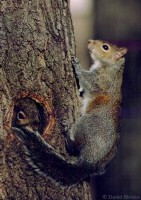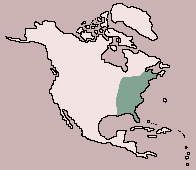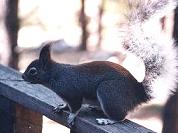
TRANSCRIPT
INTRODUCTION
If you walk through
a forest anywhere in North America, you're likely to hear the scolding chatter
of a tree Squirrel. These lively creatures are among our most popular and
visible wild animals.
We watch Squirrels, in city parks or in our
backyards, collecting nuts and acorns to store for the Winter. But how much do
we really know about their life in the wild?
From the tiny Red Squirrel
to the handsome husky Fox Squirrel, these tree-top acrobats come in a wide range
of sizes and colors. Let's take a look at the unusual and often unseen behavior
of these "BUSHYTAILS."
Squirrels are highly
specialized. They have adapted to the tree tops as have few other
mammals.
SQUIRREL RUNNING ON POWER LINE
With sharp, hook-like
claws for clinging to bark, and a large, fluffy tail for balance, they are
well-equipped for life above ground. One of the most notable characteristics of
Squirrels is their compatibility with humans. They arouse our sense of wonder
and they amuse us with their gravity-defying acrobatics.
Squirrels were not always as popular as they are today. During
colonial times, Gray Squirrels were so abundant that they threatened the crops
of pioneer farmers, especially their corn. It's been estimated that before the
dense eastern hardwoods were cleared for farmland, a billion Gray Squirrels
roamed the forests.
In the 1700's, bounties were imposed to control these
voracious pests. A few colonies even accepted Squirrel scalps as payment for
taxes. Colonists became such marksmen from shooting Squirrels, they devastated
the ranks of British soldiers during the American Revolution later.
Only
a small fraction of the once enormous Gray Squirrel population exists today. But
they are still the most familiar of all the North American
Squirrels.
DRAWING OF DIFFERENT SQUIRREL SPECIES Even more common
than the Gray Squirrel, yet rarely seen, is the nocturnal Flying Squirrel. This
species is our smallest native Squirrel, weighing only 2 to 3 ounces.
Even more common
than the Gray Squirrel, yet rarely seen, is the nocturnal Flying Squirrel. This
species is our smallest native Squirrel, weighing only 2 to 3 ounces.
The
Douglas Squirrel, below, also called Chicory, inhabits the coniferous forests of
our Pacific coastal states.
The Red Squirrel, above, makes up for its
small size by being the noisiest.
The versatile Gray Squirrel, so named
for its salt and pepper fur, is equally at home in woodland, suburb, or city
park.
The Ponderosa Pine forests of the western US. are home to the
beautiful Tassel-eared Squirrels, the Abert's Squirrel, on the right, and the
darker Kaibab Squirrel, on the left.
The Fox Squirrel is the largest of
all, weighing up to three pounds. This species exhibits a wide variety of color
phases.
The best season to
observe Squirrels is autumn, when most of their time is spent foraging on the
ground, collecting nuts and seeds. Like the Fox Squirrel, chipmunks also store
food for the winter.
Some of their favorites are Acorns, Hickory nuts,
Beechnuts, Walnuts and Maple seeds.
It was once believed that Squirrels
could remember where they buried each nut. But experiments indicate that, within
a half hour, they forget these locations. Now we know they find food, buried
under leaves and even snow by using their keen sense of smell. Ironically, the
nuts that Squirrels eventually dig up aren't necessarily the same ones they
buried.
With abundant food, the Squirrels fatten quickly. Their extra
weight will sustain them through the lean months ahead.
BURYING NUTS AND
SEEDS
Gray Squirrels are equally industrious. One ambitious bushytail can
bury thousands of nuts and seeds by the time winter arrives.
Each
Squirrel works fast and furious to hoard its winter food supply, for the
competition is intense. Deer, bears, hogs and turkeys also feast on the
nutritious mast.
GRAY SQUIRREL
 Both Fox and Gray Squirrels are
found throughout the entire eastern half of the United States. They've also been
released into parts of the west. The adaptable Gray Squirrel has even been
introduced into England where it now drives out the native Red
Squirrels.
Both Fox and Gray Squirrels are
found throughout the entire eastern half of the United States. They've also been
released into parts of the west. The adaptable Gray Squirrel has even been
introduced into England where it now drives out the native Red
Squirrels.
Autumn is a time of restlessness for most animals, and the
tree Squirrels are no exception. Juveniles, born during February or March, must
leave their birthplaces and find a home of their own.
During this "fall
shuffle," the inexperienced young often fall prey to Hawks, Bobcats, Foxes and
Martens.
HUMAN HUNTER
Human hunters also stalk the colorful
woods.
Squirrels outwit their predators, human and otherwise, by hiding
behind a tree trunk until the danger passes.
HUNTER GATHERING SHOT
SQUIRRELS
Approximately 40 million Squirrels are shot annually by
hunters. While over-hunting can reduce populations in isolated woodlands,
Squirrel numbers are more influenced by severe weather and disease than by
hunting.
With the threat gone, the juveniles resume their playful
games.
All too soon, the fall colors slip
away.
RED SQUIRREL/WHITE FOOTED MOUSE
Only the high-pitched bark
of a Red Squirrel pierces the hush of the winter woods.
In cold weather,
Squirrels are rarely seen in the open. Even so, they don't hibernate like their
ground Squirrel cousins. The Red Squirrel of our northern Evergreen forests
avoids the icy winds by digging a network of tunnels under the
snow.
White-footed mice also seek shelter in the Squirrel's
tunnels.
The Red Squirrel is the most territorial of all the tree
Squirrels, with good reason. It caches nuts and pine cones in one pile which
must then be protected from other hungry
rodents.
COURTING/MATING
In late December, the mating season is
ushered in by a chorus of chattering Squirrels.
Squirrel courtship
involves more fighting than courting. Male Squirrels will chase a female for
hours in a frenzied attempt to mate with her. Though unwilling to mate at first,
the female leaves scent marks along the branches, enticing her suitors to
follow. Several males join in the chase and fight one another for mating
privileges.
It's believed that the female's protests serve to intensify
the competition between males.
The stronger the competition, the better
her chances are that the strongest, most dominant male will
persevere.
ALBINO GRAY SQUIRREL
An albino Gray Squirrel watches
the commotion from a nearby tree.
Besides eliminating the weaker or
inexperienced males as potential mates, the ritualized mating chases also
stimulate ovulation in the female.
The males are polygamous, meaning they
will mate with as many females as they can catch.
The interbreeding
between normal Grays and Albino's may produce offspring that are gray, white, or
even pure black. These color variations are simply genetic mutations in their
pigment and apparently have no bearing in matters of courtship.
FOX
SQUIRREL
While the Gray Squirrels range from white to black, Fox
Squirrels exhibit an even greater diversity of fur color, the greatest, in fact,
of any North American mammal.
For now, this male gives up the chase and
settles for a sweet taste of tree sap.
Squirrels are members of the
largest order of mammals, the Rodents. Fossil evidence suggests that rodents
originated in North America and evolved into many different species from a
common, Squirrel-like ancestor.
Rodents proved so adaptable that they
invaded almost every major ecological niche in an amazingly brief span of about
two million years.
The
appearance of springtime flowers, mushrooms and tree buds provides a banquet for
woodland creatures.
This female Fox Squirrel returns to her den to nurse
her four week old young, snuggled beneath a blanket of leaves.
A male Fox
Squirrel, with no parental responsibilities, continues to dine on the succulent
buds.
While male and juvenile Squirrels are very social and often den
together, neither are tolerated in the same nest as a female with
young.
FLYING SQUIRRELS/FULL MOON
Tree Squirrels are most active
at dusk and dawn, with one exception. As the moon rises, Flying Squirrels begin
their nighttime forays, gliding from tree to tree like furry kites. The Flying
Squirrel's name is a misnomer since it can't fly. But it can glide up to fifty
feet by spreading the loose flaps of skin along its sides.
Like most
Squirrels, they nest in natural tree cavities or abandoned woodpecker holes.
When fleas and other parasites become intolerable, the female moves her litter
to a new den. A baby finds comfort in its fresh bed of shredded
bark.
Tree Squirrels normally produce one litter a year, but, if food is
plentiful, they will nest twice. Once in early spring and again in mid- summer,
after the young from the first litter leave the nest.
MOTHER FLYING
SQUIRREL MOVING BABIES/NURSING
A typical litter for Flying Squirrels is
three, but there may be anywhere from two to six young. The baby Squirrels are
weaned at eight to nine weeks, but they may remain with their mother for up to
three months. Young tree Squirrels take longer to develop than most other
mammals their size. This ensures that their coordination and eyesight are highly
developed by the time they face life on their own.
About 10,000 years ago, a species of Tassel-eared Squirrel
inhabited the forests of the American southwest. As the Kaibab Plateau rose on
the north rim of the Grand Canyon, the Squirrels there became geographically
isolated from those on the south rim.
Two sub-species eventually
evolved.
ABERT'S SQUIRREL
The more common and widespread of the
Tassel-eared Squirrels is the Abert's Squirrel. Its range overlaps that of the
Ponderosa Pine, on which it depends for food and cover.
Besides eating
the pine cone seeds, the Squirrels survive the critical months of winter eating
the cambium, or inner bark, the Ponderosa.
They also eat Truffles, a
subterranean fungi. Truffles enhance the health of the forest by providing
moisture and nutrients to the pine tree's roots. The Squirrels help spread the
fungi by leaving spores in their droppings.
It's a three-way relationship
that helps to propagate the fungi and the pine trees, while providing food for
the Squirrels.
Living at an elevation of six to nine thousand feet their
mating season begins as late as April or May. The young are born about forty
days later.
KAIBAB SQUIRREL A subspecies of the Abert's, the
Kaibab Squirrel, was cut off from its ancestral population by the Grand Canyon
to the south and treeless deserts to the east, north and west.
A subspecies of the Abert's, the
Kaibab Squirrel, was cut off from its ancestral population by the Grand Canyon
to the south and treeless deserts to the east, north and west.
Separated,
they evolved distinctive characteristics such as a dark gray belly and pure
white tail. But the Kaibab, too, depends on the Ponderosa pine.
As with
other members of its family, mating is preceded by a high-speed chase through
the forest.
The Kaibab Squirrel provides scientists with a rare look at
how geographic isolation affects an animal's development. The few miles that
separate the Kaibab and Abert's Squirrels can be measured in thousands of years
of evolution.
We tend to give more attention to rare or seldom-seen
animals. Yet, however common, Squirrels are no less important.
We should
value tree Squirrels not only for their unique role in nature, but also for the
touch of wildness they bring to our civilized
world.
CONCLUSION
Squirrels provide us with a close-up look at
nature. We enjoy watching their antics and we benefit from them in another, less
obvious way. Since every buried seed or nut is a potential tree, the health of
our woodlands is enhanced by these rodents.
As long as their habitat is
preserved, forests will always resound with a persistent chatter of
"BUSHYTAILS".